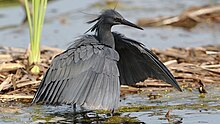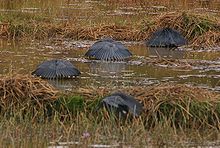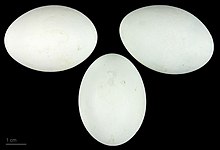| Black heron | |
|---|---|

| |
| Black heron canopy feeding | |
| Conservation status | |
 Least Concern (IUCN 3.1) | |
| Scientific classification | |
| Domain: | Eukaryota |
| Kingdom: | Animalia |
| Phylum: | Chordata |
| Class: | Aves |
| Order: | Pelecaniformes |
| Family: | Ardeidae |
| Genus: | Egretta |
| Species: | E. ardesiaca |
| Binomial name | |
| Egretta ardesiaca (Wagler, 1827) | |
The black heron (Egretta ardesiaca), also known as the black egret, is an African heron. It uses its wings to form a canopy when fishing.
Description



The black heron is a medium-sized bird, with a typical height range of 42.5 to 66 cm (16.7 to 26.0 in). Their weight can range from 0.27 to 0.39 kg (0.60 to 0.86 lb). They are known for their black plumage, black bill, and yellow feet. In breeding plumage it grows long plumes on the crown and nape.
Distribution and habitat
The black heron occurs patchily through Sub-Saharan Africa, from Senegal and Sudan to South Africa, but is found mainly on the eastern half of the continent and in Madagascar. It has also been observed in Greece, Italy and the United States.
It prefers shallow open waters, such as the edges of freshwater lakes and ponds. It may also be found in marshes, river edges, rice fields, and seasonally flooded grasslands. In coastal areas, it may be found feeding along tidal rivers and creeks, in alkaline lakes, and tidal flats.
Habits
The black heron uses a hunting method called canopy feeding — it uses its wings like an umbrella, creating shade that attracts fish. This technique was documented on episode 5 of the BBC's The Life of Birds, and in the "Nighttime Daytime" sketch from BBC's Walk on the Wild Side. Some have been observed feeding solitarily, while others feed in groups of up to 50 individuals, 200 being the highest number reported. The black heron feeds by day but especially prefers the time around sunset. It roosts communally at night, and coastal flocks roost at high tide. The primary food of the black heron is small fish, but it will also eat aquatic insects, crustaceans and amphibians.
The nest of the black heron is constructed of twigs placed over water in trees, bushes, and reed beds, forming a solid structure. The heron nests at the beginning of the rainy season, in single or mixed-species colonies that may number in the hundreds. The eggs are dark blue and the clutch is two to four eggs.
References
- BirdLife International (2016). "Egretta ardesiaca". IUCN Red List of Threatened Species. 2016: e.T22696926A93593568. doi:10.2305/IUCN.UK.2016-3.RLTS.T22696926A93593568.en. Retrieved 12 November 2021.
- "Egretta ardesiaca (Wagler, 1827)". Integrated Taxonomic Information System (ITIS) (https://www.itis.gov). Retrieved 2016-11-13.
{{cite web}}: External link in|publisher= - ^ James Hancock; James Kushlan (1984). The Herons Handbook. Croom Helm. pp. 101–104. ISBN 0-7099-3716-4.
- "Hellenic Rarities Committee Annual Report – 2012" (PDF). Hellenic Ornithological Society. 2012. p. 2.
- David Attenborough (1998). Life of Birds. BBV. pp. 122–123. ISBN 0563-38792-0.
External links
- Black Heron - Egretta ardesiaca The BioFresh Cabinet of Freshwater Curiosities
- Black Egret - The Atlas of Southern African Birds
- Video - Black Heron displaying Canopy Feeding Technique
| Taxon identifiers | |
|---|---|
| Egretta ardesiaca |
|